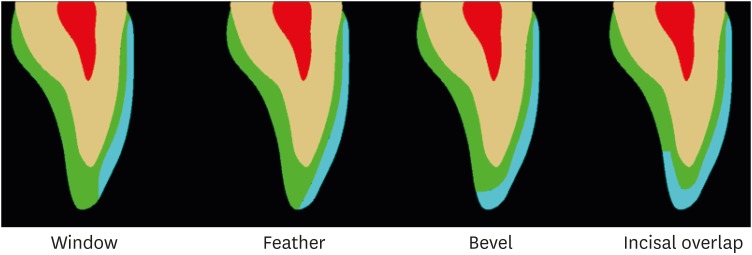-
Influence of thickness and incisal extension of indirect veneers on the biomechanical behavior of maxillary canine teeth
-
Victória Luswarghi Souza Costa, João Paulo Mendes Tribst, Eduardo Shigueyuki Uemura, Dayana Campanelli de Morais, Alexandre Luiz Souto Borges
-
Restor Dent Endod 2018;43(4):e48. Published online November 12, 2018
-
DOI: https://doi.org/10.5395/rde.2018.43.e48
-
-
 Abstract Abstract
 PDF PDF PubReader PubReader ePub ePub
- Objectives
To analyze the influence of thickness and incisal extension of indirect veneers on the stress and strain generated in maxillary canine teeth. Materials and MethodsA 3-dimensional maxillary canine model was validated with an in vitro strain gauge and exported to computer-assisted engineering software. Materials were considered homogeneous, isotropic, and elastic. Each canine tooth was then subjected to a 0.3 and 0.8 mm reduction on the facial surface, in preparations with and without incisal covering, and restored with a lithium disilicate veneer. A 50 N load was applied at 45° to the long axis of the tooth, on the incisal third of the palatal surface of the crown. ResultsThe results showed a mean of 218.16 µstrain of stress in the in vitro experiment, and 210.63 µstrain in finite element analysis (FEA). The stress concentration on prepared teeth was higher at the palatal root surface, with a mean value of 11.02 MPa and varying less than 3% between the preparation designs. The veneers concentrated higher stresses at the incisal third of the facial surface, with a mean of 3.88 MPa and a 40% increase in less-thick veneers. The incisal cover generated a new stress concentration area, with values over 48.18 MPa. ConclusionsThe mathematical model for a maxillary canine tooth was validated using FEA. The thickness (0.3 or 0.8 mm) and the incisal covering showed no difference for the tooth structure. However, the incisal covering was harmful for the veneer, of which the greatest thickness was beneficial.
-
Citations
Citations to this article as recorded by 
-
194
View
-
4
Download
-
6
Crossref
|




